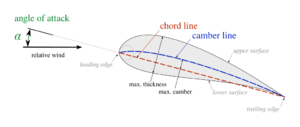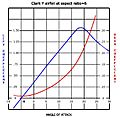Airfoil facts for kids
An airfoil (also called an aerofoil in some places) is the special shape of a wing or blade. You can see this shape if you cut through a wing, like on an airplane. This unique design helps things move through air or water. When an airfoil moves, it creates a force called lift and another force called drag. Lift isn't always just upwards; it can push in different directions depending on what the airfoil is used for.
Contents
Understanding Airfoils: The Shape of Flight
What Makes an Airfoil Special?
An airfoil is a carefully designed shape. It is often curved on top and flatter on the bottom. This special curve helps it interact with the air or water it moves through. Think of it like a smooth, streamlined tear-drop shape.
This shape is not just for looks. It is engineered to create forces that allow things to fly or move efficiently. Without airfoils, airplanes could not take off. Ships would also struggle to move through water.
How Does an Airfoil Create Lift?
The main job of an airfoil is to create lift. Lift is the force that pushes an object up or in a specific direction. When an airfoil moves through the air, the air flows faster over the curved top surface. At the same time, the air flows slower along the flatter bottom surface.
This difference in speed creates a difference in pressure. The faster-moving air above has lower pressure. The slower-moving air below has higher pressure. This higher pressure underneath pushes the airfoil upwards, creating lift. It is like a gentle push from below.
What About Drag?
While lift is important, another force called drag is also created. Drag is the force that resists motion. It tries to slow the airfoil down. Think of it as air resistance.
Engineers design airfoils to create a lot of lift but as little drag as possible. This balance is key for efficient flight or movement. A good airfoil helps an airplane fly far using less fuel.
Where Do We See Airfoils?
Airfoils are all around us, even if we do not always notice them. They are not just on airplanes.
- Airplane Wings: This is the most common example. The wings of an airplane are airfoils. They create the lift needed for the plane to fly.
- Propellers: The blades of an airplane's propeller are also airfoils. They spin around, creating a forward push called thrust. This thrust pulls the plane through the air.
- Helicopter Blades: Each blade on a helicopter's rotor is an airfoil. They spin very fast to create the lift that makes the helicopter hover and fly.
- Wind Turbine Blades: The giant blades of a wind turbine are airfoils. Instead of creating lift to fly, they use the wind to spin. This spinning motion generates electricity.
- Sails on Boats: Even the sails on a sailboat act like airfoils. They use the wind to create a force that pushes the boat forward.
- Ship Propellers: The blades of a ship's propeller, sometimes called a screw, are airfoils designed to push water. This creates thrust to move the ship.
Key Parts of an Airfoil
Every airfoil has specific parts that help it work.
- Leading Edge: This is the very front part of the airfoil. It is the first part to meet the air or water.
- Trailing Edge: This is the very back part of the airfoil. It is where the air flow comes back together after passing over the airfoil.
- Chord Line: Imagine a straight line drawn from the leading edge to the trailing edge. This is the chord line.
- Camber: This refers to the curve of the airfoil. A highly curved top surface has more camber. Different amounts of camber affect how much lift an airfoil can create.
Engineers carefully choose the right airfoil shape for each job. A fighter jet needs a different airfoil than a slow cargo plane. This is because they have different speed and lift requirements.
Images for kids
-
An airfoil designed for winglets (PSU 90-125WL)
See also
 In Spanish: Perfil alar para niños
In Spanish: Perfil alar para niños





